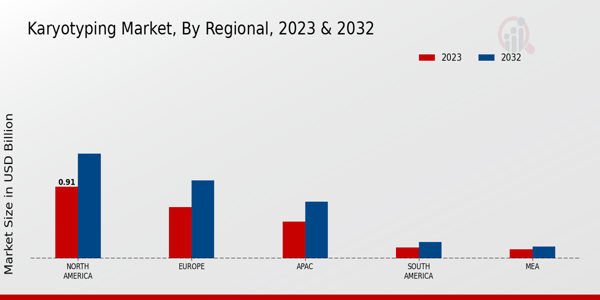Market Growth Projections
The Global Karyotyping Market Industry is on a growth trajectory, with projections indicating a market size of 2.52 USD Billion in 2024 and an anticipated increase to 4.22 USD Billion by 2035. This growth is underpinned by a compound annual growth rate (CAGR) of 4.81% from 2025 to 2035. The increasing prevalence of genetic disorders, advancements in technology, and rising demand for prenatal testing are key factors contributing to this upward trend. As the market evolves, it is expected to adapt to emerging healthcare needs and technological innovations, ensuring its relevance in the future.
Expansion of Clinical Applications
The Global Karyotyping Market Industry is experiencing growth due to the expansion of clinical applications for karyotyping. Beyond traditional uses in prenatal testing and cancer diagnostics, karyotyping is increasingly utilized in reproductive health and personalized medicine. This diversification of applications enhances the relevance of karyotyping in various medical fields. As healthcare providers recognize the value of karyotyping in tailoring treatment plans, the market is likely to see sustained growth. The integration of karyotyping into routine clinical practice may lead to improved patient outcomes and a broader acceptance of genetic testing.
Growing Demand for Prenatal Testing
The rising demand for prenatal testing is a significant driver of the Global Karyotyping Market Industry. Expecting parents are increasingly opting for genetic screening to assess the risk of chromosomal abnormalities in their unborn children. This trend is fueled by heightened awareness and education regarding genetic health. As a result, karyotyping plays a crucial role in prenatal diagnostics, providing essential information for informed decision-making. The market is anticipated to expand as more healthcare providers incorporate karyotyping into routine prenatal care, ensuring early detection and management of potential genetic issues.
Rising Prevalence of Genetic Disorders
The increasing incidence of genetic disorders globally drives the demand for karyotyping services. Genetic disorders such as Down syndrome and Turner syndrome are becoming more prevalent, necessitating accurate diagnostic tools. In 2024, the Global Karyotyping Market Industry is projected to reach 2.52 USD Billion, reflecting the urgent need for effective genetic testing. As awareness of genetic conditions grows, healthcare providers are increasingly adopting karyotyping to ensure early diagnosis and intervention. This trend is likely to continue, as advancements in technology enhance the accuracy and efficiency of karyotyping, thereby expanding its application in clinical settings.
Technological Advancements in Karyotyping
Innovations in karyotyping technology significantly enhance the capabilities of genetic analysis. Techniques such as next-generation sequencing and array comparative genomic hybridization are revolutionizing the Global Karyotyping Market Industry. These advancements allow for higher resolution and faster results, making karyotyping more accessible to healthcare providers. As a result, the market is expected to grow, with projections indicating a rise to 4.22 USD Billion by 2035. The integration of artificial intelligence in data analysis further streamlines the karyotyping process, potentially increasing its adoption in various medical fields, including oncology and prenatal diagnostics.
Increased Government Funding for Genetic Research
Government initiatives aimed at promoting genetic research and diagnostics are pivotal in driving the Global Karyotyping Market Industry. Increased funding for research projects and public health programs enhances the availability of karyotyping services. For instance, various countries are investing in genetic screening programs to identify hereditary conditions early. This financial support is expected to bolster the market, contributing to a projected CAGR of 4.81% from 2025 to 2035. Such investments not only improve healthcare outcomes but also foster collaboration between public and private sectors, further advancing karyotyping technologies.




















Leave a Comment